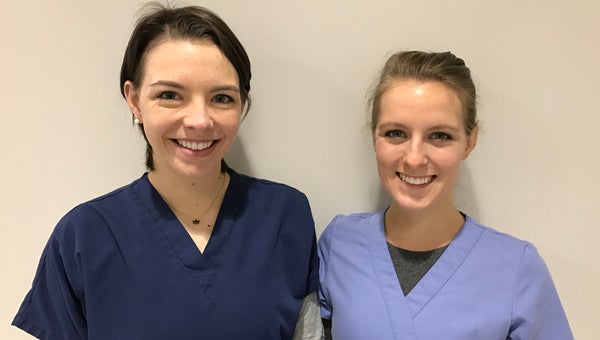Aquatic therapy helps with pain
Published 12:03 am Wednesday, January 11, 2017

- Aquatic therapists Hannah Arcement and Dori Waltz feel aquatic therapy offers an alternative or supplement to land-based exercise programs.
Exercise can be either too difficult or painful for many physical conditions and diseases.
In cases of chronic hip, knee or back pain, obesity, neurological disorders such as stroke, multiple sclerosis, and Parkinson’s disease, people often spiral toward increasing health-related illness and debility for lack of ability to safely or comfortably move or exercise.
Aquatic therapy is an alternative or supplement to land-based exercise programs that often can be very beneficial in allowing people to use the properties of water to effectively exercise in a safe environment and improve overall health.
Aquatic therapy uses the properties of water including buoyancy, hydrostatic pressure, and resistance.
• Buoyancy, the force of upward thrust in the opposite direction of gravity, decreases weight bearing and compression forces on joints, decreases stress on tissues, supports weakened muscles, and enhances flexibility and range of motion. Buoyancy also increases the latency period for falling, which allows more opportunity to compensate.
• Hydrostatic pressure is the force exerted on an immersed body in equal portions. Benefits of hydrostatic pressure include decreasing pain and edema, increasing circulation, and improving inspiration/exhalation ability.
• Resistance from water viscosity (drag) improves muscle tone, muscle balance, and cardiac output. Additionally, the temperature of the water in a therapy pool is set to allow for warmth and distraction of pain receptors. The water bombards the nervous system with sensory input, which travels on larger, faster conducting fibers than pain, thus blocking pain input.
Thibodaux Regional’ Rehabilitation Center offers traditional aquatic therapy, as well as the state-of-the-art Hydroworx therapy pool, and has two certified aquatics therapists on staff.
The Hydroworx pool, located in the Aquatics Center of the Wellness Center includes a patented underwater treadmill that uses the buoyant forces of water to allow for walking/running in multiple conditions, earlier in the rehab process than would be available or advisable in land-based programs.
Underwater cameras allow a patient and the therapist to monitor movements for proper mechanics and make adjustments as necessary.
Adjustable water depths allow for optimal de-weighting of a patient according to his or her specific protocol or needs.
The combination of treadmill therapy and de-weighting can improve the biomechanics of gait, which formerly would be postponed in orthopedic injuries until a patient is pain free or the tissue is further healed.
In neurologic patients, the cameras and treadmill offer valuable feedback for gait abnormalities and progression of treatment. The Hydroworx pool also incorporates hydro massage jets, which allow therapists to direct progressive resistance for increased conditioning, strength, and flexibility, as well as, being used for deep tissue massage.
Along with all the physical benefits, patients also experience improved self-confidence, relaxation, and decreased anxiety and depression.
Aquatic therapy can be the opportunity for many people to begin their journey to wellness and improved well-being.
Prior to beginning any exercise program, a patient should discuss the opportunity with his or her doctor, and should then be evaluated by a physical therapist to determine if aquatics alone or in conjunction with a land-based program will benefit him or her in reaching his or her health goals.
For more information about aquatic therapy contact the Rehabilitation Center of Thibodaux Regional, 985-493-4782.
— Contributed by aquatic therapists Dori Waltz, PT, DPT and Hannah Arcement, PT, DPT

